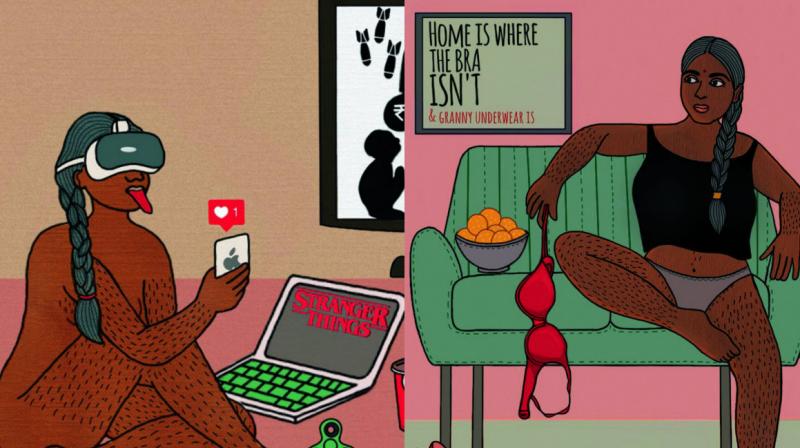Dishing out the dirt
A quick glance into various social media timelines may project happiness that seems unattainable.

A quick glance into various social media timelines may project happiness that seems unattainable. The stream of airbrushed selfies, flawless lifestyles of celebrities, vacation check-ins to exotic locales, fitness goals, or even a good hair day achieved can create a feeling of inadequacy.
This “seemingly perfect social media” life is what got 27-year-old illustrator Kaviya thinking. With glorious, picture-perfect moments making a mainstay on social media timelines, Kaviya realised that real issues need to be dealt with on it too. “As a generation, we are dealing with complicated relationships, mental health, addictions to our mobile phones, sexuality and body negativity,” sighs Kaviya.
So, in an age where happy depictions of lives are a dictum, she decided to create #100daysofdirtylaundry — a parody on 100-day challenges — as a tool to have real, meaningful interactions.
“As much as I was happy for my friends and acquaintances on social media posts, the whole online set-up seemed a little bit constructed and unreal to me. If I had to judge the lives of people by how they appeared online, I would sweepingly make the conclusion that most of us are living happy, fulfilling lives,” rationalises Kaviya, who hasn’t been able to escape the trappings of social media either.
As part of her creative process, Kaviya learns more about the topics to understand the bigger picture. “I also don’t want to make loose arguments for the sake of it,” she states.
Even as Kaviya makes a conscious effort to choose topics that is relevant to people between 18 to 35 years of age, her posts on anxiety, addictions, fears and cynicism are universal issues. One of her posts talks about the joys of doing away with the stigma of women’s body hair. “Let men be men and women be women. Who are these ideal men and women anyway? And what’s masculine and what’s feminine anyway? (sic)” she wrote. Another post talks of embracing body positivity, despite size and stretch marks. Then there are some which take on the social constructs — like the one where a young girl casually breaks wind.
She explains, “These are still taboos we don’t openly address in our society. It feels weird to acknowledge them, be it topics like menstruation or harassment. All the unhappy, ‘dirty’ bits get brushed off to the back to serve our immediate need for likes and validation. The more we talk about it, the more nomalised these ‘taboos’ will become.”
A self-taught artist, Kaviya explains that her style is still a work-in-progress. “I think this is a journey any artist who is starting out goes through,” she says, adding that she previously drew inspiration from Indian mythology and folk art, since those empowered her femininity.
It’s not all a bed of roses for Kaviya, who reveals that she faces her share of creative blocks as well. “I try to create at least one to two posts per week to build discipline. But I have also taken conscious breaks for weeks together since I couldn’t overcome it no matter how much I tried,” she rues.
Having managed to create one impactful post after another, Kaviya admits that the feedback has been overwhelming. But with the attention, comes a responsibility. “Now I am trying to translate my personal feminine form, with all my bodily imperfections, into my art. As much as social media is about encouraging one’s personal expressions, it is also about owning up and being responsible, since my work will likely influence strangers who find it relatable. I constantly have to remind myself why I started the project in the first place (to objectively look at taboos) and be true to whatever work I am putting out in the open,” she concludes.

